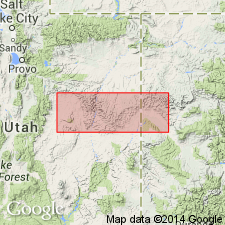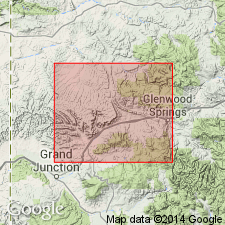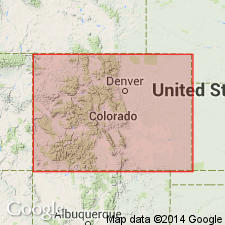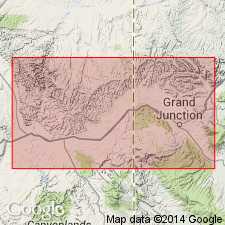
- Usage in publication:
-
- Cozzette member
- Modifications:
-
- Named
- Dominant lithology:
-
- Sandstone
- Coal
- AAPG geologic province:
-
- Piceance basin
Summary:
Named as a member (1 of 5) of Price River formation in its Neslen facies, or coal-bearing facies, for exposures near the old Cozzette mine north of Palisade, Mesa Co, CO in the Piceance basin. No type locality designated. Consists of littoral marine sandstone "and associated coal-bearing rocks." [Total thickness not given.] Basal sandstone, massive and buff-colored, grades downward into Mancos shale. Upper limit is a disconformity between the Cozzette and the Mancos. Is older than the Cameo member (new), uppermost member of the Price River in its Neslen facies. Mancos separates Cozzette from Cameo. Of Montana, Late Cretaceous age. [Full areal extent not stated.]
Source: GNU records (USGS DDS-6; Denver GNULEX).

- Usage in publication:
-
- Cozzette Member
- Modifications:
-
- Revised
- Areal extent
- Age modified
- Overview
- AAPG geologic province:
-
- Piceance basin
- Eagle basin
Summary:
Reassigned to Mesaverde Formation (revised) in southern Piceance and Eagle basins and is correlated with part of Iles Formation (revised) of Mesaverde Group in northeast Piceance basin, western CO. Fig. 2 is an electric log correlation across southern Piceance basin from surface section at Hunter Canyon, Mesa Co, east to surface section at South Canyon Creek, Garfield Co. Unit is about 200 ft thick at Hunter Canyon and can be traced across southern Piceance basin to outcrop at South Canyon Creek. Fig. 3 is correlation of measured sections along Grand Hogback from North Thompson Creek, Pitkin Co, Eagle basin, northward to White River, Rio Blanco Co, Piceance basin. Unit may occur as far as 10 mi south of North Thompson Creek. Thickens northward along Grand Hogback from 21 ft at North Thompson Creek to 148 ft at Harvey Gap. Cozzette can be differentiated from underlying Corcoran Member (revised) of Mesaverde at least as far north as Rifle Gap and possibly to Piceance Creek. Farther north at White River, northeast Piceance basin, Cozzette is correlated with part of nonmarine part of Iles. Separated from underlying Corcoran and overlying Rollins Sandstone Member (revised) of Mesaverde or equivalent Trout Creek Sandstone Member of Iles by marine tongues of Mancos Shale. Isopach map. Fossils are within EXITELOCERAS JENNEYI and DIDYLMOCERAS STEVENSONI faunal zones indicating Campanian (Late Cretaceous) age.
Source: GNU records (USGS DDS-6; Denver GNULEX).

- Usage in publication:
-
- Cozzette Sandstone Member
- Modifications:
-
- Areal extent
- Overview
- AAPG geologic province:
-
- Piceance basin
- Eagle basin
Summary:
Assigned to Iles Formation (revised) of Mesaverde Group. Plate 2 is cross section of measured sections along Grand Hogback, western CO, from Coal Basin area, Pitkin Co, Eagle basin, north to White River, near Meeker, Rio Blanco Co, Piceance basin (Mancos Shale and Iles parts of sections are taken from Warner (1964)). Cozzette is basal sandstone of Iles from Coal Basin area north to between Four Mile Creek and South Canyon where it is 50 ft thick (and where underlying Corcoran Sandstone Member of Iles pinches out). Somewhere south of Coal Basin, Cozzette passes by facies change into Mancos Shale and the overlying Rollins Sandstone Member of Iles becomes entire representation of Iles. Significant coal occurs within unit at Piceance Gap. Chart comparing nomenclature of previous workers. Late Cretaceous age.
Source: GNU records (USGS DDS-6; Denver GNULEX).

- Usage in publication:
-
- Cozzette Sandstone Member*
- Modifications:
-
- Revised
- Areal extent
- AAPG geologic province:
-
- Piceance basin
Summary:
Reassigned as middle sandstone member of Mount Garfield Formation along Book Cliffs in Mesa Co, Garfield Co, and Delta Co, CO in the Piceance basin. Intertongues with, overlies and underlies shale tongues of Mancos Shale. Also may overlie Corcoran Sandstone Member and underlie Rollins Sandstone Member, both of Mount Garfield. Has a maximum thickness of about 220 ft. Western limit is about 1 mi west of Dry Gulch in sec 30, T8S, R101W in Mesa Co. Is still present in T13S, R93W in Delta Co. Mapped in the subsurface in Ts7-9S, Rs98-100W, Mesa and Garfield Cos on cross section. Correlation diagram. Measured sections. Of Late Cretaceous age.
Source: GNU records (USGS DDS-6; Denver GNULEX).
For more information, please contact Nancy Stamm, Geologic Names Committee Secretary.
Asterisk (*) indicates published by U.S. Geological Survey authors.
"No current usage" (†) implies that a name has been abandoned or has fallen into disuse. Former usage and, if known, replacement name given in parentheses ( ).
Slash (/) indicates name conflicts with nomenclatural guidelines (CSN, 1933; ACSN, 1961, 1970; NACSN, 1983, 2005, 2021). May be explained within brackets ([ ]).

